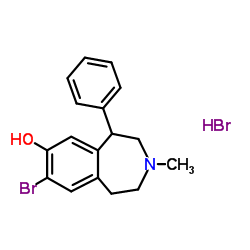108179-91-5
| Name | 8-Bromo-3-methyl-5-phenyl-2,3,4,5-tetrahydro-1H-3-benzazepin-7-ol hydrobromide (1:1) |
|---|---|
| Synonyms |
MFCD04039787
8-Bromo-3-methyl-5-phenyl-2,3,4,5-tetrahydro-1H-3-benzazepin-7-ol hydrobromide (1:1) 1H-3-Benzazepin-7-ol, 8-bromo-2,3,4,5-tetrahydro-3-methyl-5-phenyl-, hydrobromide (1:1) |
| Description | SKF-83566 hydrobromide is a potent, blood-brain permeable and orally active dopamine D1/D5 receptor antagonist[1]. SKF-83566 is a competitive DAT (dopamine transporter) inhibitor with an IC50 of 5.7 μM and attenuates cocaine effects in vivo[2]. |
|---|---|
| Related Catalog | |
| Target |
D1 Receptor D5 Receptor |
| In Vitro | SKF-83566 (0.1 μM-10 μM) causes a concentration-dependent increase in peak evoked extracellular DA concentration ([DA]o) evoked by single-pulse stimulation, with a maximum 65% increase in peak evoked [DA]o with 5 μM. The EC50 value of this effect of SKF-83566 is 1.3 μM[2]. SKF-83566 inhibited [3H]DA uptake with an IC50 of 5.73 μM. Moreover, SKF-83566 more potently inhibits the binding of [3H]CFT, a cocaine analog, with an IC50 of 0.51 μM in [3H]DA uptake and [3H]CFT binding studies. Similarly, in LLc-PK-rDAT cell, SKF-83566 also inhibits [3H]CFT binding with an IC50 of 0.77 μM in LLc-PK-rDAT cell membrane preparations[2]. |
| In Vivo | SKF 83566 hydrobromide (oral administration; 20 µg/mL; 7 days) alone has no effects on altering LTP (115%). However, combinnation of SKF 83566 and nicotine significantly blocks the enhancement of long-term synaptic potentiation (LTP) induced by pretreatment with nicotine (SKF 83566+nicotine+cocaine, 120%; nicotine+cocaine, 143%)[1]. Animal Model: Male C57BL6/J mice (6- to 9-wk-old)[1] Dosage: 20 µg/mL (Together with nicotine for 7 d, followed by the injection of cocaine) Administration: Oral administration; 7 days Result: Blocked nicotine and cocaine-induced facilitation of LTP. |
| References |
| Molecular Formula | C17H19Br2NO |
|---|---|
| Molecular Weight | 413.147 |
| Exact Mass | 410.983337 |
